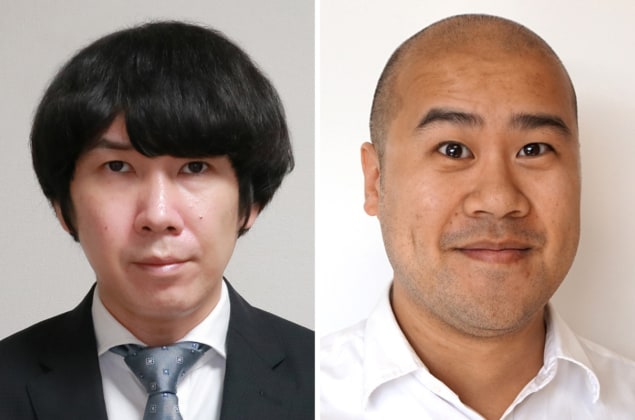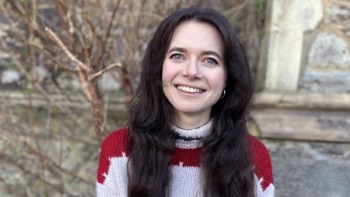Akihiro Kojima and Mike Lee are two of seven physicists who shared the 2022 Rank Prize for Optoelectronics for developing new materials for solar cells. They speak to Laura Hiscott about how they switched into different career areas long after doing the work that led to the award

Congratulations on winning the 2022 Rank Prize for Optoelectronics for your work on perovskite semiconductors. Could you explain why these materials are so important for solar power?
Akihiro Kojima: Perovskites are compounds with the general formula ABX3, where A and B are cations and X is an anion. In the subset of perovskites called organometal halides, A represents organic ions, B represents metal ions and X represents halide ions. This type of perovskites can take organic/inorganic hybrid structures. Some of these compounds have the characteristics of direct semiconductors and exhibit strong light absorption, which are important properties for solar cells.
Mike Lee: One advantage of these perovskites over other solar-cell materials is that they are very abundant and easy to process, mostly requiring low-temperature processing. When I was a researcher, the big vision was that we could one day print highly efficient solar cells in the same way we print newspapers. We were initially talking about a 3–4% energy conversion efficiency of these compounds, then I achieved around 10%. Now we’re in the 20s, which is close to silicon solar-cell performance. And that’s an established technology, so it’s really impressive stuff. I think it’s notable that there are lots of start-up companies popping up in this area, which are trying to bridge that gap between academic research and actual applications and products. So I think that’s really exciting.
The prize was awarded to you and five other people for “demonstrating the early potential of perovskites”. What specific aspects of this topic did each of you work on?
AK: I have studied perovskite materials since 2005, at which time I had a rough idea that they could be used in solar cells. In 2009, I co-authored a paper published in the Journal of the American Chemical Society, reporting that solar cells using two specific organometal halide perovskites respond in the visible light regime. I struggled to actually create a solar cell based on these perovskites because no one knew how to get high concentrations of perovskite precursors at that time. I checked the solubility of the compounds in many solvents, and one day I found that a team working on capacitors in the same laboratory as me was using gamma-butyrolactone, and discovered the solvent that dissolves my perovskite compositions. This helped me to create solar cells using the perovskites. The energy conversion efficiency in my papers was not comparable to current perovskite solar cells, but I showed the potential of these compounds to be applied to solar cells in the early stages.
ML: I followed up on Akihiro’s work. I flew over to Japan to visit him and learned how to make this material at Toin University in Yokohama. One of the early challenges was how to stabilize it. I always found that I would make it, and then it would quickly turn back into whatever kind of mush it began as. So we played about with different compositions and used different solvents until we could stabilize it in ambient conditions. The next step was to put it into a solar cell. An innovative step in the team I was in during my PhD at the University of Oxford was that we were one of the first groups to make this perovskite solar cell in a solid-state form, using solid-state materials, which really improved the stability and we had some really good performance, so that was our contribution to this research.
Akihiro, after finishing your PhD in 2010, you worked at Peccell Technologies for several years, and then in 2018 moved to Zeon, a company that researches and manufactures synthetic rubber materials. What made you switch to this field?
AK: Zeon is a well-known company for synthetic rubbers, but we are also conducting research and development on many other materials. I’m interested in investigating different kinds of materials and doing research similar to my work on perovskites. I can’t say exactly which materials will be developed next in our company, but you can expect to see new ones. I hope it will include perovskite materials for solar cells.
Mike, in 2014 you started a postdoctoral fellowship at the Paul Scherrer Institute (PSI) in Switzerland – was your research still on perovskites?
ML: Yes, it was related. My goal at the PSI was to be able to create these hybrid perovskite materials in a controllable way and then study them with the instruments available to me there. The goal was pretty ambitious. I really wanted to achieve atomistic control and be able to characterize them too. Being there was a really good experience.
Then, in 2016, you went into scientific publishing, first at Springer Nature, before becoming the editor of Science Robotics. What made you move into publishing?
ML: That’s a good question. There are multiple reasons for my pivot from research into publishing. Editing was a great opportunity to continue doing the things I really enjoyed about research: having intellectual freedom, attending conferences, doing lab visits and supporting the advancement of science. It meant that I still got to work with some really smart people, including my colleagues and our authors.
Do either of you find there is any connection between what you do now and your earlier research that you have won the prize for?
AK: Of course, there are connections. I developed my basic research skills while I was working on perovskite solar cells. For example, when I evaluate materials I use many types of equipment and techniques, such as absorption spectrum analysis, scanning electron microscopy and X-ray diffraction. I know how to use them and how to do the data analysis because I learned this basic knowledge when I was studying perovskite solar cells.
ML: I still work closely with academics and research institutions, though my research topics have shifted a bit. I think the main connection between what I did before and what I do now is that there’s still this drive from my side to help advance science. That’s important to me.
What does it feel like to win a share of a prestigious prize for work you did as an early-career researcher several years ago?
AK: I’m greatly honoured to receive the 2022 Rank Prize for Optoelectronics, and I would like to share this honour with my supervisors and my family. When I was a PhD student I was trying to do something novel with my research. I was worried about the future of perovskite solar cells after my 2009 paper, but then Mike visited Japan and he published such a good result. I was very excited to see the result and I expect perovskites to become popular materials for solar cells. Now we have received the Rank Prize together. I’m very pleased that these efforts have been recognized by the award. The experiments have given me fresh energy and inspiration. That is why I am still tackling new materials development now.
ML: It felt odd initially, but in a good way. It was surprising because it’s been a while since I’ve even thought about these materials. Early-career researchers rarely get any recognition for these sorts of prizes, and if they do then it tends to be seen as a “junior prize”, and you’re not considered the same as your peers. But we’re sharing this award with our supervisors, mentors, role models – a lot of people we really looked up to as young researchers. So it’s huge for us. I think it’s incredibly progressive of the Rank Prize to even consider early-career researchers for such an honour.
Try to figure out what is actually important to you and don’t compromise on that
Mike Lee
Do you have any advice for someone in academia who might be thinking about switching their career path?
AK: If you are thinking of following a career path into industry, you will be expected not only to have basic research abilities, but also to have product-development skills. Of course, it is important to get research achievements too. But in the process of obtaining these, it is useful to be aware of factors like the costs, productivity and safety of materials. I think that experience will definitely be valuable for your career.

Ask me anything: Giulia Grancini – ‘I’m very lucky as a scientist, because my job is also my passion’
ML: Have an honest conversation about what success really looks like. Try to figure out what is actually important to you and don’t compromise on that, the rest you can forget. Success in academia is often painted as a sequence of collecting of titles – but it doesn’t have to be that way. Think about what you enjoyed most during your time in academia and think about what you least enjoyed, then use that insight to guide what you do next and try to surround yourself with people who challenge you. For me, scientific publishing gives me a lot of intellectual freedom and the opportunity to continue to support the advancement of science.



